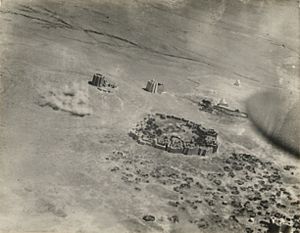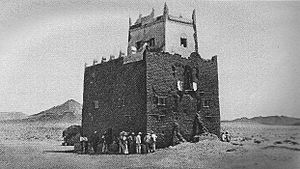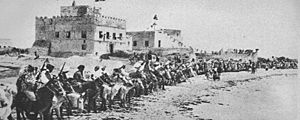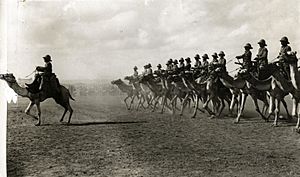Somaliland campaign facts for kids
Quick facts for kids Somaliland campaign |
|||||||
|---|---|---|---|---|---|---|---|
| Part of the Scramble for Africa and the First World War (1914–1918) |
|||||||
 Aerial bombardment of Dervish forts in Taleh |
|||||||
|
|||||||
| Belligerents | |||||||
| Dervish movement Supported by: |
|||||||
| Commanders and leaders | |||||||
| Mohammed Abdullah Hassan Haji Sudi † Nur Ahmed Aman Ismail Mire |
|||||||
| Casualties and losses | |||||||
| 200 British dead | 4,000 dead | ||||||
| 100,000–150,000 Somali civilians killed | |||||||
The Somaliland campaign, also known as the Anglo-Somali War or the Dervish War, was a series of military battles. These battles took place between 1900 and 1920 in what is now Somalia. The British were helped by the Ethiopians and Italians.
During First World War (1914–1918), the Dervish leader Mohammed Abdullah Hassan got some help. He was supported by the Ottoman Empire and Emperor Iyasu V of Ethiopia. The fighting ended when the British used planes to bomb the Dervish capital of Taleh in February 1920.
Contents
Why the Conflict Started
British Somaliland's Beginnings
For a while, parts of Somaliland were under the control of Muhammad Ali, who ruled Egypt. This was between 1821 and 1841. After Egypt left, a successful Somali merchant named Haj Ali Shermerki bought the rights to control the city of Zeila. He wanted to control all the trade in the area.
Later, in the 1870s, the Egyptians got official permission from the Ottomans to claim the city. They also got British agreement for their control along the coast. However, Egypt's rule in the area was short, lasting only a few years.
In the late 1880s, the British Somaliland protectorate was formed. This happened after local Somali leaders signed agreements with the British. These agreements gave Britain access to their lands on the northwestern coast.
When the Egyptians left the city of Harar in 1885, Zeila became important. Both France and Britain wanted to control this area near the Gulf of Aden. They almost fought, but instead, they talked. In 1888, they signed an agreement. This agreement set the border between French Somaliland and British Somaliland.
Italian Somaliland's Beginnings
The Majeerteen Sultanate was a kingdom in northeastern Somalia. It became powerful in the 18th century under King Osman Mahamuud.
In 1888, Yusuf Ali Kenadid, the leader of the Sultanate of Hobyo, asked Italy for protection. They signed a treaty in 1889, making Hobyo an Italian protectorate. Soon after, King Osman also asked for and received Italian protection.
Both leaders hoped Italy would help them achieve their own goals. Sultan Kenadid wanted Italy's help in his power struggles. The leaders also hoped to use the competition between European powers. They wanted to keep their lands independent. The treaties said Italy would not interfere with how the sultanates were run.
In exchange for Italian weapons and money, the local leaders agreed to some Italian oversight. Italy also sent ambassadors to help both sides. These new protectorates were managed by Vincenzo Filonardi. Later, in 1894, Britain and Italy signed an agreement about their borders.
The Battles Begin
Early Fights (1900–1902)
The first attack was led by the Dervish leader, the Haroun. In March 1900, he attacked an Ethiopian camp at Jijiga. The Ethiopians pushed back the attack. The Haroun took control of the Ogaden region. He did not attack Harar, but he raided other clans for their camels and weapons.
In 1901, the British and Ethiopians joined forces. They attacked the Dervishes with 17,000 soldiers. The Haroun was forced to retreat into the Majeerteen Sultanate. This area was part of the Italian protectorate. The Ethiopians did not gain control of western Ogaden. The British also had to retreat without achieving their goals. In this campaign, "borders were ignored by both British and Somali."
A British officer, Lt-Col. Alexander Cobbe, received a special medal. He was given the Victoria Cross for his brave actions at Erego in October 1902.
More Battles (February–June 1903)
The British realized they needed Italy's help. In 1903, Italy allowed the British to land troops at Hobyo. An Italian naval commander worried the mission might fail. He thought the Dervish leader would become a legend and a problem for Italy.
The relationship between Hobyo and Italy became difficult. Sultan Kenadid did not want British troops to land in his Sultanate. He did not want them to fight the Dervish forces. Italy saw Kenadid as a threat. He was sent away, first to Aden Protectorate, then to Italian Eritrea. His son, Ali Yusuf, was also exiled. In May, the British realized their mistake. Kenadid's son was made regent, just in time to stop an attack by the Sultan's army.
This expedition soon failed. The Haroun destroyed a British group near Gumburru. He then forced another group back at Daratoleh. Three officers received Victoria Crosses for trying to save a fellow officer. The Haroun had many rifles, ponies, and spearmen. He took control of the Nugal Valley. The main British force retreated north. By the end of June, their retreat was complete.
Final Push (January–May 1904)
After the British failed, General Charles Egerton was put in charge. After much planning, he gathered his forces on January 9, 1904. The next day, he defeated the Haroun at Jidballi. The British and their allies chased the Haroun as he retreated. He lost many camels and animals in February.
In early March, the second part of the operations began. The Ethiopians advanced but turned back in early April. The Italian Navy bombed Ilig in the winter, but it had no effect. On April 16, British ships left Berbera. They planned to capture Ilig with help from land forces. The attack on Ilig happened on April 21. British naval forces, helped by soldiers, stormed and captured the forts at Illig. The ships' guns supported the attack. The British lost 3 men, and 11 were hurt. The Dervishes lost 58 killed and 14 wounded. The naval group stayed for four days. An Italian naval group arrived on April 22 to help. Control of Ilig was finally given to Ali Yusuf of Hobyo. After defeating his forces, the British "offered the Mullah safe conduct into permanent exile at Mecca." The Haroun did not reply.
The End of the Conflict (1920)
After World War I ended, British troops focused again on Somaliland. The Dervishes had defeated British forces before, at the Battle of Dul Madoba in 1913. Four British attempts to defeat Hassan and his soldiers had also failed.
In 1920, British forces launched a final campaign against the Dervishes. Most of the fighting happened in January. But British troops had started getting ready in November 1919. The British forces were led by the Royal Air Force. Ground troops included the Somaliland Camel Corps. After three weeks of battle, the Dervishes were finally defeated. This ended their 20-year resistance.
Images for kids







